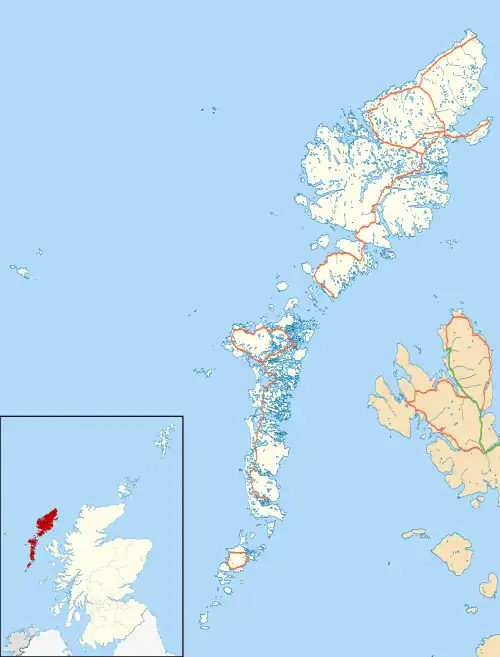Tong
| |
|---|---|
 Tong School | |
 Tong Location within the Outer Hebrides | |
| Population | 527 (2001) |
| Language | Scottish Gaelic English |
| OS grid reference | NB448365 |
| Civil parish | |
| Council area | |
| Lieutenancy area | |
| Country | Scotland |
| Sovereign state | United Kingdom |
| Post town | ISLE OF LEWIS |
| Postcode district | HS2 |
| Dialling code | 01851 |
| Police | Scotland |
| Fire | Scottish |
| Ambulance | Scottish |
| UK Parliament | |
| Scottish Parliament | |
Tong (Scottish Gaelic: Tunga from Old Norse: Tunga) is a village on the Isle of Lewis, Scotland, 4 miles (6 kilometres) northeast of the main town of Stornoway on the B895 road to Back and Tolsta.[1] The population of the village is 527 (2001 census). Fishing forms part of the local economy.[2]
The mainland of Scotland is 40 nautical miles (75 kilometres) away via a two-hour ferry ride.[3]
History
Until the 13th century, Lewis – and Tong with it – was part of Norway. Fishing, farming and weaving made up Tong's economy by the 1800s.[3] Later in the century, landlords throughout much of Lewis ousted their tenants to install sheep farms and deer forests, industries which used huge swathes of land with few farmers.[4] Many families moved to Tong, causing "horrific overcrowding."[3] Scottish historian James Hunter quotes a mainland land manager's 1828 description: “It is worse than anything I ever saw in Donegal [in Ireland] where I always considered human wretchedness to have reached its very acme.”[3] Th
Between 1919 and 1921, Tong, along with nearby Coll and Gress, was the scene of several land raids. (See the Coll, Lewis article for more).
During the land raids, men raided estates with absentee landlords by planting crops and marking out farms on land used for sheep herding. Tong in particular was considered particularly radical; John Maclean, a Scottish socialist, who visited the area after World War I, "saw it as a "hotbed of insurrection" during a visit after World War I, and even through the 1990s, Tong’s residents were called "Bolshiveeks" by a Stornoway slang dictionary.[3]
Tong's economy struggled in the early 1900s – crops were failing, the herring industry lost its main clients due to American Prohibition and the Russian Revolution, the 1918 flu epidemic killed many, and World War I killed thousands more of Hebridean men and the government failed to keep its promises of land for the survivors, pulverizing the summer social seasons where young people found their future spouses over putting the sheep out to graze. Though emigration was long a trend on Lewis, all these factors increased the rate significantly.[3]
Circa 2016, Tong received much attention due to the candidacy of U.S. President Donald Trump, whose mother was born in Tong. The land nearby is described as flat and marshy with fields of peat, with fishing and sheep farming still parts of the local economy.[3]
Facilities
The village has a community centre with a football pitch and a primary school. Its religious establishments include a Free Church of Scotland mission house and a Scottish Episcopal Church meeting house. On 6 August 2014 The Tong Shop (Bùth Thunga) opened in the former Episcopal Church building. The shop is open from Monday to Saturday and it sells a range of essentials such as milk and bread, as well as local produce such as vegetables and Stornoway black pudding.
Culture and sport
Every July the Lewis Highland Games and Western Isles Strongest man are held at the community centre with heavy events such as tossing the caber, Highland dancing, bagpipe competitions and other attractions taking place on the football pitch. The Lewis Highland Games have been held at Tong since 1977 and is the second oldest Games on the isle of Lewis. The local football club is Tong FC.
Notable people
- Sìne NicFhionnlaigh, who composed the song "Fear a' bhàta", lived in Tong in the 1800s
- Mary Anne MacLeod , mother of former U.S. President Donald Trump, was born in Tong
- Alasdair White, fiddler with the Battlefield Band, was born in Tong
Gallery
 Fàilte gu Tunga (entering Tong from direction of Coll)
Fàilte gu Tunga (entering Tong from direction of Coll) View towards Point (An Rubha), Broadbay (Loch a Tuath) and Stornoway Airport (Port-adhair Steòrnabhagh)
View towards Point (An Rubha), Broadbay (Loch a Tuath) and Stornoway Airport (Port-adhair Steòrnabhagh) Tong football pitch and community centre
Tong football pitch and community centre Tong Community Centre
Tong Community Centre Main Road looking towards Coll
Main Road looking towards Coll Towards Coll
Towards Coll Towards the crossroads
Towards the crossroads Into the village (Point across the bay in the background)
Into the village (Point across the bay in the background)
References
- ↑ Maps (Map). Google Maps.
- ↑ Great Britain. Parliament. House of Commons (1957). Parliamentary debates (Hansard).: House of Commons official report. H.M.S.O. Retrieved 20 May 2012.
- 1 2 3 4 5 6 7 Geoghegan, Peter (11 May 2016). "The Tiny Scottish Village That Spawned Trump". POLITICO Magazine. Retrieved 18 May 2023.
- ↑ Hunter, James (January 1972). "Sheep and deer: Highland sheep farming, 1850–1900". Northern Scotland. 1 (First Series (1): 199–222. doi:10.3366/nor.1972.0015. ISSN 0306-5278.
External links
- Tong Primary School
- Visitor's guide for the Isle of Lewis
- Website of the Western Isles Council with links to other resources
- Disabled access to Lewis for residents and visitors